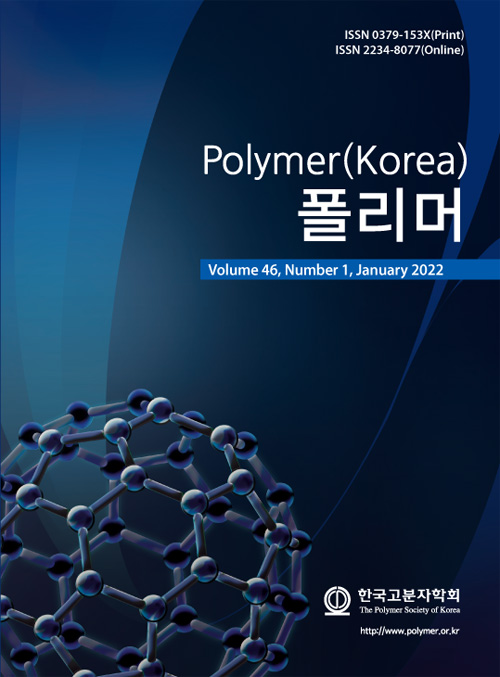- Preparation of Biodegradable Poly(lactic acid)-Cellulose Composite Foam
Department of Chemical Engineering and Materials Science, Chung-Ang University, 84 Heukseok-ro, Dongjak-gu, Seoul 06974, Korea
- 생분해성 Poly(lactic acid)-셀룰로오스 다공성 복합체의 제조
중앙대학교 공과대학 화학신소재공학과
Reproduction, stored in a retrieval system, or transmitted in any form of any part of this publication is permitted only by written permission from the Polymer Society of Korea.
In this study, a cellulose foam was formed by the melt crystallization method of cellulose (FP) solution, and poly(lactic acid) (PLA) solution was then infiltrated into the foam to prepare a PLA/FP composite foam. When PLA is infiltrated into the cellulose porous material with a hydrophilic surface, the surface is transformed into a hydrophobic one. The PLA/FP composite foam showed a higher density and improved mechanical properties than the FP foam. In terms of porosity, the FP foam showed a higher value than the PLA/FP composite foam, but the PLA/FP composite foam had better thermal insulation properties as seen in through-plane thermal conductivity. Thermal stability at a high temperature was better for the PLA/FP composite foam than for the FP foam. Due to its high mechanical properties and thermal stability, the PLA/FP composite foams are expected to have the potential as insulation and cushioning materials in the future.
본 연구에서는 셀룰로오스(FP) 용액의 냉각 결정화 방법으로 폼을 형성한 후, 생분해성 고분자인 poly(lactic acid)(PLA) 용액을 폼에 침투시켜서 복합체 폼을 제조했다. PLA를 친수성 표면을 가진 셀룰로오스 다공성 소재에 침투시키면, 소수성의 표면으로 개질된다. PLA/FP 복합체 폼에서 FP 폼보다 높은 밀도와 기계적 물성 특성을 확인할 수 있었다. 기공도는 FP 폼이 PLA/FP 복합체 폼보다 높은 수치를 보였지만, 수직 열전도도에서 확인한 단열성은 PLA/FP 복합체 폼이 더욱 우수했다. 또한 고온 열적 안정성도 FP 폼보다 PLA/FP 복합체 폼이 뛰어났다. PLA/FP 복합체 폼은 높은 기계적 물성과 열적 안정성으로 향후 단열재, 완충재로서 가능성을 가질 것으로 기대된다.
Keywords: cellulose, poly(lactic acid), foam, melt crystallization, composites.
- Polymer(Korea) 폴리머
- Frequency : Bimonthly(odd)
ISSN 0379-153X(Print)
ISSN 2234-8077(Online)
Abbr. Polym. Korea - 2023 Impact Factor : 0.4
- Indexed in SCIE
 This Article
This Article
-
2022; 46(1): 101-106
Published online Jan 25, 2022
- 10.7317/pk.2022.46.1.101
- Received on Sep 28, 2021
- Revised on Nov 2, 2021
- Accepted on Nov 8, 2021
 Correspondence to
Correspondence to
- Jonghwi Lee
-
Department of Chemical Engineering and Materials Science, Chung-Ang University, 84 Heukseok-ro, Dongjak-gu, Seoul 06974, Korea
- E-mail: jong@cau.ac.kr









 Copyright(c) The Polymer Society of Korea. All right reserved.
Copyright(c) The Polymer Society of Korea. All right reserved.